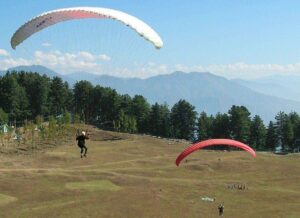Last Updated on October 1, 2020 at 8:28 pm
The Union Territories of Jammu and Kashmir and Ladakh have gained popularity because of its climate. The climate of both the Union Territories is greatly influenced by the mountains surrounding along with the water bodies in the areas.
As the altitude varies in J&K and Ladakh, the regions experience a different climate. While Kashmir has a moderate temperature, its climate is largely controlled by the Himalayas, Ladakh is a cold region with extreme temperatures, its climate is very dry and Jammu is a sub-tropical region with sufficient sunshine and hot temperature in summer while the cold temperature in winters, the climate is different in different parts of the region.
But from the past few years, climate change has become a problem of J&K and Ladakh. Climate change has become a great challenge to human survival in the three regions. Climate change can be observed from the study of temperature and precipitation. According to the study in the Jammu region, the temperature is changing at a rate of 0.3 to 0.6 degrees Celsius per decade and in Kashmir valley, the temperature is varying at a rate of 4 to 5 degrees Celsius per decade. In the same manner, the temperature in Ladakh is rising at a rate of 1.6-degree Celsius.
According to the study published in the journal climatic change predicted that J&K and Ladakh may witness a temperature increase of upto 6.9 degrees Celsius by the end of the 21st century. The study was conducted using the ensemble of 11 models under 3 greenhouse gas emission scenarios.
The regions which have been included in the study are Jammu, Kashmir, Gilgit- Baltistan, and many other regions across the Line Of Control (LoC). The average annual temperatures are expected to increase in three different scenarios. In the first scenario, the temperature is supposed to increase by 4.5-degree Celsius, in second by 3.98-degree Celsius, and in third by 6.93 degrees Celsius.
A lead author of research told PTI that this increase of 6.9 degrees Celsius in temperature in J&K and Ladakh is much more than the expected average rise in international temperature by the end of the century. He further added that if the emission of greenhouse gasses is not maintained immediately then the global temperature could rise to 5 degrees Celsius by the end of the twenty-first century.
In the same scenario, India’s temperature is expected to rise by 4.4 degrees Celsius approximately. Climate change in both the UTs of J&K and Ladakh will have a severe impact on every sector that is contributing to the economy.
A professor of Kashmir University said that the glaciers are the most important resource of the region and if these projections will come true then the glacier in the region will reduce by 85%.
This reduction will lead to depletion of stream flows in the region. The shortage of water bodies will affect the major sectors like agriculture, horticulture, and even tourism on which most people depend for their livelihood. Currently, horticulture gives us the revenue of rupees 9,000 crores and the government says that this sector has the potential to grow upto 30,000 crores.
He further said that though J&K and Ladakh have fewer industries still they are bearing the effect of climate change as the phenomenon has its dimensions and impact globally.
Among a few sources that have contributed to the climate change in J&K and Ladakh is tourism. No doubt that the tourism sector is growing in the Union Territories but due to tourism the water resources have depleted and the air and land pollution has also increased which has degraded the ecosystem to a great extent.
Another reason for climate change is hydrological power projects. Large scale construction of dams and hydropower projects have affected the ecosystem. The third reason for climate change is deforestation. The region has faced rapid urbanization and trees are being cut for the construction of roads and colonies. Deforestation has given rise to soil erosion and land degradation leading to the depletion of diverse flora and fauna.
The changing climate has affected Jammu and Kashmir and Ladakh over the years and it will worsen as time passes. The government should take action. Development is necessary but there should be a balance between the environment and development. New measures should be formulated and aligned with local conditions.
The government and the local communities should find ways to tackle climate change with a new approach to aware people of the threat of climate change. There is a need to develop a fresh framework that will maintain a balance between the environment and development.







